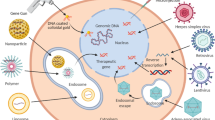Abstract
Zinc-finger nucleases (ZFNs) are powerful tools for experimental gene manipulation. A number of recent papers have shown how this technology can be applied effectively to models of human gene therapy. Significant target genes and useful methods of ZFN delivery have been reported. Important strides have been made in minimizing toxic side effects observed with some ZFNs, which bodes well for their ultimate safety. New tools are available for the design and testing of ZFNs for new target genes. Applications of ZFNs to stem cells have been described, and genuine gene therapy trials appear to be on the immediate horizon.
This is a preview of subscription content, access via your institution
Access options
Subscribe to this journal
Receive 12 print issues and online access
$259.00 per year
only $21.58 per issue
Buy this article
- Purchase on Springer Link
- Instant access to full article PDF
Prices may be subject to local taxes which are calculated during checkout


Similar content being viewed by others
References
Cathomen T, Joung JK . Zinc-finger nucleases: the next generation emerges. Mol Therapy 2008; 16: 1200–1207.
Porteus MH . Mammalian gene targeting with designed zinc finger nucleases. Mol Therapy 2006; 13: 438–446.
Santiago Y, Chan E, Liu P-Q, Orlando S, Zhang L, Urnov FD et al. Targeted gene knockout in mammalian cells by using engineered zinc-finger nucleases. Proc Natl Acad Sci USA 2008; 105: 5809–5814.
Lombardo A, Genovese P, Beausejour CM, Colleoni S, Lee Y-L, Kim KA et al. Gene editiing in human stem cells using zinc finger nucleases and integrase-defective lentiviral vector delivery. Nat Biotechnol 2007; 25: 1298–1306.
Perez EE, Wang J, Miller JC, Jouvenot Y, Kim KA, Liu O et al. Establishment of HIV-1 resistance in CD4+ T cells by genome editing using zinc-finger nucleases. Nat Biotechnol 2008; 26: 808–816.
Maeder ML, Thibodeau-Beganny S, Osiak A, Wright DA, Anthony RM, Eichtinger M et al. Rapid ‘Open-Source’ engineering of customized zinc-finger nucleases for highly efficient gene modification. Mol Cell 2008; 31: 294–301.
Meng X, Noyes MB, Zhu LJ, Lawson ND, Wolfe SA . Targeted gene inactivation in zebrafish using engineered zinc-finger nucleases. Nat Biotechnol 2008; 26: 695–701.
Doyon Y, MaCammon JM, Miller JC, Faraji F, Ngo C, Katibah GE et al. Heritable targeted gene disruption in zebrafish using designed zinc-finger nucleases. Nat Biotechnol 2008; 26: 702–708.
Moehle EA, Rock JM, Lee Y-L, Jouvenot Y, DeKelver RC, Gregory PD et al. Targeted gene addition into a specified location in the human genome using designed zinc finger nucleases. Proc Natl Acad Sci USA 2007; 104: 3055–3060.
Beumer K, Bhattacharyya G, Bibikova M, Trautman JK, Carroll D . Efficient gene targeting in Drosophila with zinc finger nucleases. Genetics 2006; 172: 2391–2403.
Morton J, Davis MW, Jorgensen EM, Carroll D . Induction and repair of zinc-finger nuclease-targeted double-strand breaks in Caenorhabditis elegans somatic cells. Proc Natl Acad Sci USA 2006; 103: 16370–16375.
Minczuk M, Papworth MA, Miller JC, Murphy MP, Klug A . Development of a single-chain, quasi-dimeric zinc-finger nuclease for the selective degradation of mutated human mitochondrial DNA. Nucleic Acids Res 2008; 36: 3926–3938.
Szczepek M, Brondani V, Buchel J, Serrano L, Segal DJ, Cathomen T . Structure-based redesign of the dimerization interface reduces the toxicity of zinc-finger nucleases. Nature Biotechnol 2007; 25: 786–793.
Cornu TI, Thibodeau-Beganny S, Guhl E, Alwin S, Eichtinger M, Joung JK et al. DNA-binding specificity is a major determinant of the activity and toxicity of zinc-finger nucleases. Mol Therapy 2008; 16: 352–358.
Pruett-Miller SM, Connelly JP, Maeder ML, Joung JK, Porteus MH . Comparison of zinc-finger nucleases for use in gene targeting in mammalian cells. Mol Therapy 2008; 16: 707–717.
Miller JC, Holmes MC, Wang J, Guschin DY, Lee Y-L, Rupniewski I et al. An improved zinc-finger nuclease architecture for highly specific genome cleavage. Nature Biotechnology 2007; 25: 778–785.
Carroll D, Morton JJ, Beumer KJ, Segal DJ . Design, construction and in vitro testing of zinc finger nucleases. Nature Protocols 2006; 1: 1329–1341.
Mandell JG, Barbas III CF . Zinc Finger Tools: custom DNA-binding domains for transcription factors and nucleases. Nucleic Acids Res 2006; 34: W516–W523.
Wright DA, Thibodeau-Beganny S, Sander JD, Wiinfrey RJ, Hirsh AS, Eichtinger M et al. Standardized reagents and protocols for engineering zinc finger nucleases by modular assembly. Nat Protoc 2006; 1: 1637–1652.
Ramirez CL, Foley JE, Wright DA, Muller-Lerch F, Rahman SH, Cornu TI et al. Unexpected failure rates for modular assembly of engineered zinc fingers. Nat Methods 2008; 5: 374–375.
Paques F, Duchateau P . Meganucleases and DNA double-strand break-induced recombination: perspectives for gene therapy. Curr Gene Ther 2007; 7: 49–66.
Calos MP . The phiC31 integrase system for gene therapy. Curr Gene Ther 2006; 6: 633–645.
Author information
Authors and Affiliations
Corresponding author
Rights and permissions
About this article
Cite this article
Carroll, D. Progress and prospects: Zinc-finger nucleases as gene therapy agents. Gene Ther 15, 1463–1468 (2008). https://doi.org/10.1038/gt.2008.145
Received:
Revised:
Accepted:
Published:
Issue Date:
DOI: https://doi.org/10.1038/gt.2008.145
Keywords
This article is cited by
-
Genetic insights, disease mechanisms, and biological therapeutics for Waardenburg syndrome
Gene Therapy (2022)
-
Genome Editing: Revolutionizing the Crop Improvement
Plant Molecular Biology Reporter (2021)
-
Target-specific gene delivery in plant systems and their expression: Insights into recent developments
Journal of Biosciences (2020)
-
Current status and perspectives of genome editing technology for microalgae
Biotechnology for Biofuels (2017)



